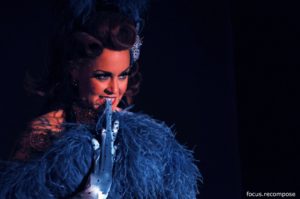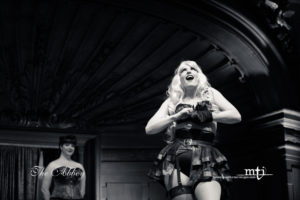
Gemma Commane. Photo from the author.
By Gemma Commane, Birmingham City University (UK)
Girls who identify with alternative femininity (e.g. non-mainstream femininity) can experience diverse, creative and exciting ways to express who they are. The alternative girl can use her creativity, her personal style and her body as a platform to voice who she is, as well expressing what she wants to change about the world. For many years, young women have been using the stage or theatre to tell their stories, and to reclaim certain aspects of their gender and identity from narrow social opinions about what girls can do, what they can achieve and how girls should look. One example of this is the rise and popularity of burlesque. Burlesque performances are engaging experiences for performer and audience member alike, with music playing an important role in creating a celebratory, fun and entertaining atmosphere. Burlesque has a long history with connections with the music hall, mime, dance, cabaret and theatre. Some of the well-known artists through its long history include Lydia Thompson and The British Blondes (late 1800s), Bettie Page (1950s) and Dita Von Teese (present day). New forms of burlesque, or ‘neo-burlesque,’ have re-emerged in the last decade or so, in alternative clubs, in the media (advertising, music videos, etc.) and in film (e.g. Burlesque starring Cher and Christina Aguilera). What is interesting about burlesque is the range of music styles used. The musical styles can be anything from classical to rockabilly, but pop music can also feature too. The music accompanying performances is dependent on the type of burlesque, what the performer wants to communicate, and even the theme of the event. Burlesque creatively engages with music, as performances use different musical styles to express different meaning (including humour), feeling and empowerment.

Photo Credit: Jenya Kushnir
Although some people may think that burlesque is crude, or that mainstream images of burlesque reinforce ‘beauty’ as thin, white and heterosexual, if we look more closely at the reasons why some young women do burlesque, we can see some very important themes. These themes connect to developments in feminist thought, particularly the third wave feminism which developed during the 1990s. Girl power, female empowerment and the independent woman all link to attitudes found in neo burlesque. There is a massive emphasis on body positivity in contemporary burlesque as all body shapes are celebrated, as well as the celebration of different bodily styles, race and ethnicity, and sexual orientation. What this can mean is a safe, likeminded and tolerant space for young women to self-express and identify with alternative femininity. Contemporary burlesque also features women with tattoos, piercings, and different hair colours. The presence and visibility of women of all shapes and sizes, with tattoos and other body modifications, is important as it shows that femininity is diverse with lots of possibilities. Many performers and academics in media and cultural studies have argued that burlesque can be seen as feminist as it can be used as a platform for young women to self-express and to challenge narrow or negative representations of femininity. Even audience members can feel empowered when watching a burlesque performance, particularly as a lot of burlesque events are mostly attended by women. The support from women by other women, is positive and it challenges wider norms in society that see alternative women as damaged or objectified.

Photo credit: Mark Turner
Some performers admire early burlesque performers as ‘proto-feminists’ or original examples of feminist work. Many performers do identify as feminist and use their image, body and performance art to comment on and reject ‘mainstream’ representations of feminine identity and feminine beauty. The reason why performers do this is dependent on their own personal experience and why they choose to perform; if you do not identify with mainstream representations of femininity, burlesque offers one way to show the world that other kinds of femininity exist. Even though there are certain styles associated with burlesque, if you look explore the burlesque community, you will see that performers and performances are diverse. This diversity is exciting, but also diversity comes with some issues when one style or depiction of ‘burlesque’ is seen to be more genuine or cool. It is easy to criticise mainstream representations of burlesque particularly as the they do not always reflect the diversity you see on the burlesque scenes in your local towns and cities. However, we also have to be careful of standards and norms being created by alternative women too in alternative scenes and spaces. What the alternative girl stands for varies and changes depending on the person, their experience and their life course. Alternative girls and women alike have always challenged social norms, and in the example of burlesque we can see how diverse femininity is. What this means is that there are many possibilities to express and to be who you are.
Discover more of Gemma Commane’s research here.
-Gemma Commane, Birmingham City University
Guest Blogger
Girl Museum
